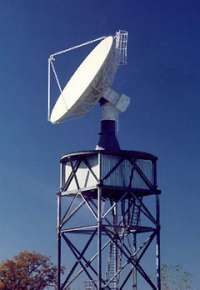Terminal Doppler Weather Radar
Description of the radar set, tactical-technical characteristics

Figure 1: TDWR
| Specifications | |
|---|---|
| frequency: | 5.5 - 5.65 GHz
( C-Band) |
| pulse repetition time (PRT): | |
| pulse repetition frequency (PRF): | 300 Hz (long-range surveillance)
1 200-1 700 Hz (Doppler velocity hits) |
| pulsewidth (τ): | 1.1 µs |
| receive time: | |
| dead time: | |
| peak power: | 250 kW |
| average power: | 550 W |
| instrumented range: | 275 NM (≙ 460 km) |
| range resolution: | |
| elevation coverage: | |
| accuracy: | |
| beamwidth: | 0.55° |
| hits per scan: | 5 rpm |
| MTBCF: | 1 500 hrs |
| MTTR: | |
Terminal Doppler Weather Radar
The Terminal Doppler Weather Radar (TDWR) is a C-Band Doppler radar designed to detect windshear and similar wind-related events in terminal air traffic control areas. It is a fully coherent, high-sensitivity, high-resolution radar using a klystron transmitter tube. The Terminal Doppler Weather Radar Antenna is an all-aluminum, solid surface, 25-foot reflector designed for both outdoor and radome environments.
The TDWR measures winds, turbulence, and storm formations in and around an airport as often as once every minute. The Doppler-effect allows the system to detect the movement of air masses that can form into a windshear or a microburst. The data processing algorithms are predictive and designed to forecast the development of microburst phenomena and project wind direction shifts. TDWR is not dependent on precipitation to determine the existence of weather activity. The Doppler radar processes detected microscopic dust particles and insects to determine wind speed and direction.

